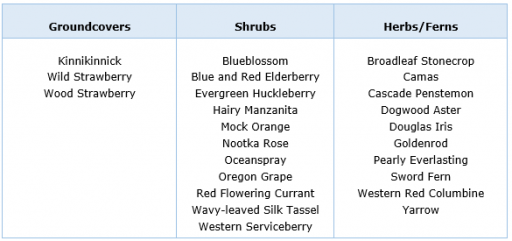Throughout much of the Northwest, spring has taken hold and the weather is beginning to take a real turn for the warmer. Whether you live in Spokane or Albany, Bend or Sequim, there are things you can be doing in your yard and garden for brighter blooms and greener greens in the months ahead according to Oregon State University Extension Service as well as Washington State University Spokane County Master Gardeners. That includes planting and tending to some of the region’s easiest-to-grow native plants.
Plan Ahead
- The warmer months are on the way, even if your neck of the woods is still below freezing overnight.
- Prepare your garden soil and add nutrients to raised beds. Add 2” of organic materials if needed.
- Once soil is consistently above 60º F, you can start planting beans, sweet corn, and other warm season vegetables.
- If weather and soil conditions are right, plant gladioli, alyssum, phlox and marigolds.
Plant Now
Aside from higher elevations where soil temperatures may still be below 60º, the following may be planted successfully in some areas.
- Coastal Regions: beets, cabbage, cauliflower, celery, chard, slicing cucumbers, leeks, lettuce, onion sets, peas, potatoes.
- Western Valleys: Broccoli, Brussels sprouts, cabbage, carrots, cauliflower, chard, chives, leeks. Lettuce, peas, radishes, rhubarb, rutabagas, spinach, turnips.
- Eastern Regions: Peas, radishes, lettuce, spinach, turnips.
Cleaning and Watering
Here are some tips to consider as you clean up the yard and begin watering.
- Don’t remove spring-flowering bulb foliage until it has turned brown and died.
- Add fertilizer to trailing berries as well as berry bushes.
- Add compost to perennial vegetables.
- Cut ornamental grasses to just a few inches above the ground.
- In the valleys, apply nitrogen fertilizer and dethatch your lawn if needed.
- In eastern areas of each state, prune deciduous trees and shrubs.
Pest and Disease Management
Removing and eliminating slugs, sowbugs, and other pets is a must this time of year.
- Use less toxic options to remove slugs from garden and planting areas.
- Monitor strawberries for insects such as aphids. Wash off with water if possible.
- Remove weeds near gardens.
- Use pheromone traps in apple or pear trees if there are invasive moths in your area.
Native Northwest Plants
While it can take up to three years for some native species to develop root systems, this list of plants are drought tolerant and do well throughout much of the Pacific Northwest.

Get Your Yard and Garden Ready at Coastal
You’ll find everything the country needs, including what your yard and garden need, at your Northwest owned and operated Coastal. Stop by for fertilizer, plants, seeds, starts, soil, and expert advice for growing just about anything in your area.
